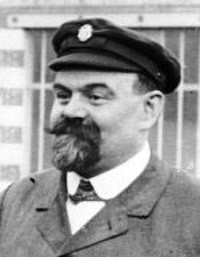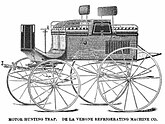
An antique car is an automobile that is an antique. Narrower definitions vary based on how old a car must be to qualify. The Antique Automobile Club of America defines an antique car as over 25 years of age. However, the legal definitions for the purpose of antique vehicle registration vary widely. The antique car era includes the Veteran era, the Brass era, and the Vintage era, which range from the beginning of the automobile up to the 1930s. Later cars are often described as classic cars. In original or originally restored condition antiques are very valuable and are usually either protected and stored or exhibited in car shows but are very rarely driven.

A cyclecar was a type of small, lightweight and inexpensive motorized car manufactured in Europe and the United States between 1910 and the early 1920s. The purpose of cyclecars was to fill a gap in the market between the motorcycle and the car. It could accommodate only two passengers, often sitting in tandem.

The Arnold was one of the first motor cars manufactured in the United Kingdom. It was produced in East Peckham, Kent between 1896 and 1898.

L'Aster, Aster, Ateliers de Construction Mecanique l'Aster, was a French manufacturer of automobiles and the leading supplier of engines to other manufacturers from the late 1890s until circa 1910/12. Although primarily known as an engine mass manufacturer the company also produced chassis for coach-works and a complete range of components.

The Duryea Motor Wagon Company, established in 1895 in Springfield, Massachusetts, was the first American firm to build gasoline automobiles.

A voiturette is a miniature automobile.

Charles Edgar Duryea was an American engineer. He was the engineer of the first working American gasoline-powered car and co-founder of Duryea Motor Wagon Company. He was born near Canton, Illinois, a son of George Washington Duryea and Louisa Melvina Turner, and died in Philadelphia, Pennsylvania, but spent most of his life working in Springfield, Massachusetts. It was in Springfield that Charles and his brother, Frank, produced and road-tested America’s first gasoline-powered car.

Delahaye was a family-owned automobile manufacturing company, founded by Émile Delahaye in 1894 in Tours, France. Manufacturing was moved to Paris following incorporation in 1898 with two marriage-related brothers-in-law, George Morane and Leon Desmarais, as Emile Delahaye's equal partners. The company built a low volume line of limited production luxury cars with coachbuilt bodies; trucks; utility and commercial vehicles; buses; and fire-trucks. Delahaye made a number of technical innovations, particular in its early years. After establishing a racing department in 1932, the company came to prominence in France in the mid-to-late 1930s, first with the International record-breaking Type 138; then, the Type 135 that famously evolved into the special short-wheelbase sports-racing Type 135CS; followed by the V12 types 145 and 155 racecars. Many races were won, and records set. The company faced setbacks due to the Second World War, and was taken over by amalgamation with arch competitor Hotchkiss in 1954. Both were absorbed by the large Brandt manufacturing organization, within months, with automotive products ended. Delahaye closed forever at the end of 1954, taking Delage along with it.
The Daimler Manufacturing Company (DMFG), was a boutique American automaker company from 1898 to 1907. From 1888 to 1898, the company was known as the Daimler Motor Company (DMC), formed under a partnership between Gottlieb Daimler of Daimler-Motoren-Gesellschaft and William Steinway of piano manufacturer Steinway & Sons. Headquartered in Long Island City, Queens, New York City near Steinway's Astoria headquarters, the company sold Daimler motors for yachts and launches, and goods vehicles including buses and trucks. It built and sold a single automobile model, the original American Mercedes.

Léon Bollée was a French automobile manufacturer and inventor.

James Frank Duryea was an American engineer and inventor who, with his brother Charles (1861–1938), invented the first American gasoline-powered automobile.

Henry John Lawson, also known as Harry Lawson, was a British bicycle designer, racing cyclist, motor industry pioneer, and fraudster. As part of his attempt to create and control a British motor industry Lawson formed and co floated The Daimler Motor Company Limited in London in 1896. It later began manufacture in Coventry. Lawson organised the 1896 Emancipation Day drive now commemorated annually by the London to Brighton Veteran Car Run on the same course.

The Lambert Automobile Company was a United States automobile manufacturing company which produced the Lambert automobile from 1905 to 1916. The company was founded by automotive pioneer John William Lambert and was based in Anderson, Indiana.
The Success Automobile Manufacturing Company was a brass era United States automobile manufacturer, located at 532 De Ballviere Avenue, St. Louis, Missouri, in 1906.

The Präsident was an automobile manufactured by the Nesselsdorfer Wagenbau-Fabriks-Gesellschaft, since 1919 Tatra, in 1897. It was the first practical, factory-produced petrol engine automobile built in Central and Eastern Europe. It was constructed by Leopold Sviták and Hans Ledwinka. The automobile was more of a carriage without horses than a car in modern sense. The car is steered via handlebars. The wooden bodywork is placed on an iron frame. It has four seats and a convertible top that would cover only the rear seats. Both axles have suspension of semi-elliptical leaf springs. The wheels were similar to the ones of a horse carriage, but had rubber tyres. The car had a two cylinder spark ignition Benz engine placed by the rear axle.

The British Motor Syndicate Limited (BMS) was a company formed in November 1895 by company promoter and entrepreneur Harry John Lawson. Lawson's aim was to use BMS to raise funds from the public to establish a business with a monopoly on petrol-driven cars by acquiring as many patents as possible related to such vehicles from Gottlieb Daimler, his business associates, and other sources.

Overman Wheel Company was an early bicycle manufacturing company in Chicopee Falls, Massachusetts from 1882 to 1900. It was known for bicycles of higher quality and lower weight than other bicycles of its time. Despite a nationwide bicycle craze in the late 1800s, the company was undercut by lower-priced competition, nearly went bankrupt in 1897, and never recovered from an 1899 fire. The company was sold in 1900.

Indiana Bicycle Company was a bicycle and automobile company in Indianapolis, Indiana, United States. The company made carriages, bicycles and electric vehicles under the name Waverley Cycles. By 1896 the company was producing 350 bicycles every ten hours.
















